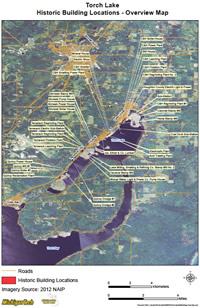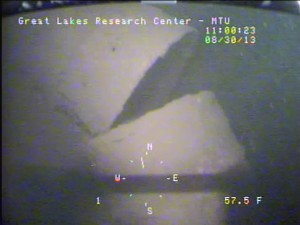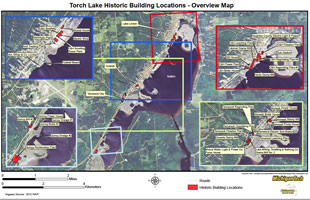LOCATION
 The Abandoned Mining Wastes – Torch Lake non-Superfund site is comprised of the risks posed by chemical containers and residues historically discarded in Torch Lake. These concerns are distinct and separate from the risks addressed at the Torch Lake Superfund site, which has been defined by the United States Environmental Protection Agency (EPA) as the top six inches of stampsand and slag in certain areas of Houghton County, and any vegetative cover applied to such areas.
The Abandoned Mining Wastes – Torch Lake non-Superfund site is comprised of the risks posed by chemical containers and residues historically discarded in Torch Lake. These concerns are distinct and separate from the risks addressed at the Torch Lake Superfund site, which has been defined by the United States Environmental Protection Agency (EPA) as the top six inches of stampsand and slag in certain areas of Houghton County, and any vegetative cover applied to such areas.

The remaining concerns at Torch Lake involve groundwater, surface water, sediments, and “upland” media. Known or suspected problems which need to be evaluated include: an unidentified, significant in-lake and/or terrestrial source of polychlorinated biphenyls (PCBs), uncharacterized waste deposits and >750 uncharacterized drums on the lake bottom, stampsands, slags, landfills, industrial ruins, coal storage areas, underground storage tanks, asbestos wastes, and any other waste materials identified in future investigations.
SITE HISTORY
In 2005, the staff of the DEQ’s Water Bureau had semi-permeable membrane devices (SPMDs) deployed to evaluate the presence of PCBs dissolved in the water column at various locations within and around Torch Lake. In 2013, staff of Michigan Technological University (Michigan Tech) considered those results, the potential volume of historic PCB source areas along Torch Lake, and conducted a “mass balance” study. Michigan Tech shared their results with the DEQ in summer 2013.
SITE DESCRIPTION
The overarching project is comprised of private and publicly held properties in several townships, villages, and cities in Houghton County, Michigan. These properties are often located along waters of the state including the Portage canal, Lake Superior, and Torch Lake (and its tributaries). The project footprint also encompasses properties including the former Centennial Mine, the Michigan Smelter, the former Quincy mill and leach plant in Mason, industrial ruins in Freda, Redridge, and Tamarack city, and other areas congruent with the Torch Lake Superfund Site where the response action has been limited to the application of vegetative cover or eliminating the area from further consideration.
 The complex nature and project footprint required that the MDEQ subdivide and prioritize the project into geographic areas based on past use and known issues. The focus of this assignment is the geographic subset known as the Calumet and Hecla (C&H) Lake Linden Operations Area (Site). Investigations will be conducted in general priority order, as funding allows, addressing all hazardous substances in all environmental media. Upon completion of investigative activities in each area, and consideration of feasible response alternatives, appropriate remedial actions will follow.
The complex nature and project footprint required that the MDEQ subdivide and prioritize the project into geographic areas based on past use and known issues. The focus of this assignment is the geographic subset known as the Calumet and Hecla (C&H) Lake Linden Operations Area (Site). Investigations will be conducted in general priority order, as funding allows, addressing all hazardous substances in all environmental media. Upon completion of investigative activities in each area, and consideration of feasible response alternatives, appropriate remedial actions will follow.